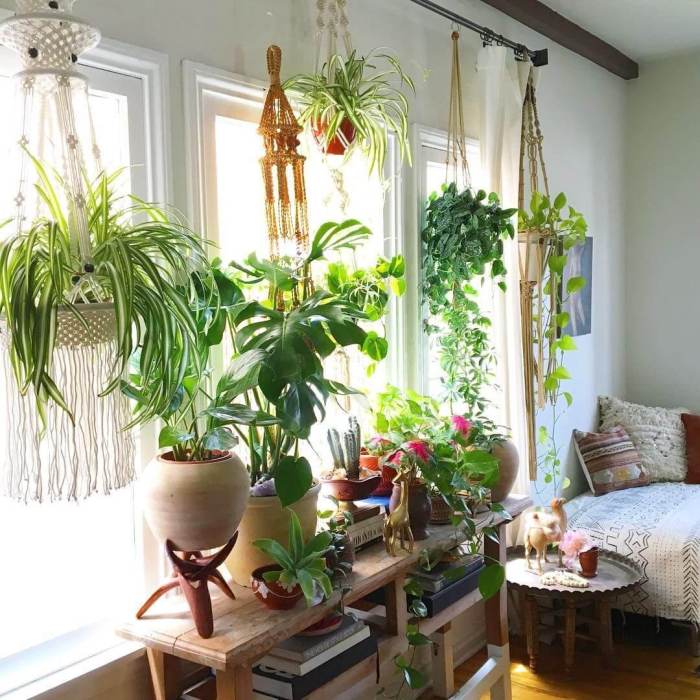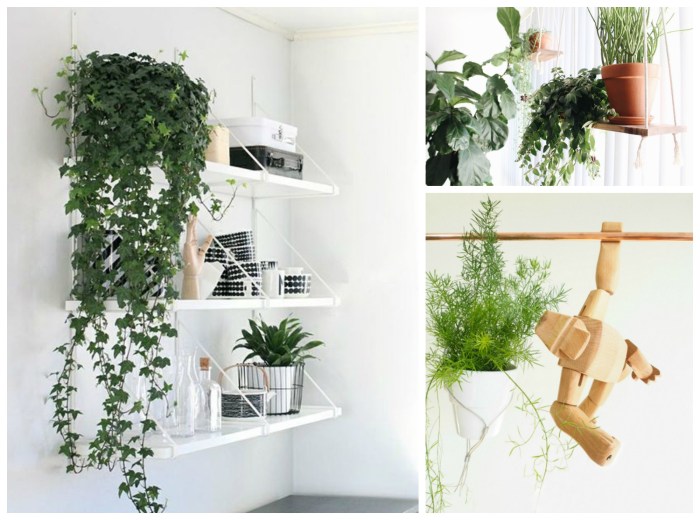Hanging house plants are a stunning way to add life, style, and health to your living space. From cascading vines to trailing succulents, these versatile plants offer a wide range of options to suit any decor and create a serene ambiance.
Not only do hanging plants enhance the aesthetics of your home, but they also purify the air, increase humidity, and boost your well-being. Embrace the beauty and benefits of hanging house plants, and transform your living space into a lush oasis.
Plant Varieties
Hanging houseplants bring a touch of greenery and life to any indoor space. They come in a wide variety of types, each with unique characteristics and care requirements. Understanding these differences will help you choose the perfect plants for your home and ensure they thrive.
Some of the most popular hanging plants include:
- Spider plant( Chlorophytum comosum): Known for its long, cascading leaves with white stripes, spider plants are easy to care for and can tolerate a range of light conditions.
- Pothos( Epipremnum aureum): Another easy-care plant, pothos has heart-shaped leaves that come in a variety of colors, including green, yellow, and white.
- String of pearls( Senecio rowleyanus): This delicate plant has long, trailing stems with tiny, bead-like leaves. It prefers bright, indirect light and infrequent watering.
- Burro’s tail( Sedum morganianum): With its plump, trailing leaves that resemble a donkey’s tail, burro’s tail is a unique and charming hanging plant. It prefers full sun to partial shade and well-draining soil.
To help you choose the right hanging plants for your home, here is a table summarizing their key care requirements:
| Plant Variety | Light Requirements | Water Needs | Humidity Preferences |
|---|---|---|---|
| Spider plant | Low to bright indirect light | Moderate | Low to medium |
| Pothos | Low to bright indirect light | Moderate | Medium |
| String of pearls | Bright indirect light | Infrequent | Low |
| Burro’s tail | Full sun to partial shade | Moderate | Low |
Hanging Techniques: Hanging House Plants

Hanging houseplants adds a touch of greenery and style to any space. There are various methods for hanging houseplants, each with its own advantages and disadvantages.
Macrame Hangers
Macrame hangers are a popular choice for hanging houseplants. They are made of knotted cords or yarn and can be customized to create unique designs. Macrame hangers are relatively inexpensive and easy to make, and they add a bohemian touch to any space.
Wire Baskets
Wire baskets are another popular option for hanging houseplants. They are sturdy and durable, and they can be used to hang a variety of plant sizes and shapes. Wire baskets are also relatively inexpensive and easy to find, and they can be painted or decorated to match any décor.
Ceiling Hooks
Ceiling hooks are a simple and effective way to hang houseplants. They are inexpensive and easy to install, and they can be used to hang a variety of plant sizes and shapes. However, ceiling hooks can be visible, and they may not be suitable for all spaces.
Hanging house plants add a touch of greenery and freshness to any room. They are a great way to bring the outdoors in and can help to purify the air. For those looking to add some hanging plants to their home, Hanging Plants offers a wide variety of options to choose from.
Whether you are looking for a trailing plant, a climbing plant, or a flowering plant, Hanging Plants has the perfect plant for you.
Benefits of Hanging Plants

Incorporating hanging plants into home decor offers a plethora of advantages, ranging from improved air quality and increased humidity to enhanced aesthetic appeal. These verdant additions not only purify the air by removing toxins but also release moisture, creating a more comfortable indoor environment.
Beyond their practical benefits, hanging plants serve as a touch of nature within the home. Their lush foliage creates a sense of coziness and tranquility, bringing the outdoors in. Studies have shown that exposure to plants can reduce stress, improve mood, and enhance overall well-being.
Improved Air Quality
- Remove toxins from the air, such as benzene, formaldehyde, and trichloroethylene.
- Release oxygen through photosynthesis, improving air circulation.
- Reduce airborne dust and allergens.
Increased Humidity, Hanging house plants
- Release moisture into the air, creating a more comfortable environment.
- Help prevent dry skin, throat, and nasal passages.
- Reduce static electricity.
Enhanced Aesthetic Appeal
- Add color and texture to a room.
- Create a sense of depth and dimension.
- Provide a focal point or accent.
Plant Care Considerations
Maintaining healthy hanging houseplants requires specific care considerations to ensure their well-being and longevity. Understanding the unique needs of each plant species and adapting care routines accordingly is essential.
Proper watering is crucial, as hanging plants can dry out more quickly than those on the ground. Allow the soil to dry slightly between waterings, and adjust the frequency based on the plant’s needs. Fertilizing should be done regularly during the growing season, using a balanced fertilizer diluted to half strength.
Pruning
Regular pruning helps maintain the desired shape and size of hanging plants. Remove dead or damaged leaves and stems, and trim back any overly long growth. Pruning encourages new growth and keeps the plant healthy.
Troubleshooting Common Problems
Common problems with hanging plants include yellowing leaves, brown tips, and pest infestations. Yellowing leaves may indicate overwatering or nutrient deficiency, while brown tips can be caused by underwatering or excessive sunlight. Pest infestations can be controlled using organic or chemical methods.
By following these care guidelines and addressing common problems, you can maintain healthy and thriving hanging houseplants that add beauty and greenery to your living space.
Plant Selection for Specific Needs
Choosing the right hanging houseplants is essential for their well-being and aesthetic appeal. Factors such as light availability, humidity levels, and personal preferences should be considered when making a selection.
Low-Light Conditions
For areas with limited natural light, opt for plants that thrive in low-light conditions, such as:
- Snake Plant (Sansevieria trifasciata): Tolerates low light and infrequent watering.
- ZZ Plant (Zamioculcas zamiifolia): Hardy plant that can withstand extended periods of drought.
- Pothos (Epipremnum aureum): Easy-to-grow plant with variegated leaves that tolerate low light.
High-Humidity Environments
In humid environments, such as bathrooms or kitchens, plants that prefer high humidity levels will thrive. Consider the following:
- Ferns (Nephrolepis exaltata): Requires regular misting or a humidifier to maintain humidity.
- Air Plants (Tillandsia spp.): Absorbs moisture from the air, eliminating the need for soil or frequent watering.
- Peace Lily (Spathiphyllum wallisii): Produces large, white flowers and prefers high humidity levels.
Pet-Friendly Homes
For homes with pets, choose non-toxic plants that are safe for both humans and animals. Some pet-friendly options include:
- Spider Plant (Chlorophytum comosum): Non-toxic and easy to care for.
- Prayer Plant (Maranta leuconeura): Non-toxic and known for its beautiful, patterned leaves.
- Orchid (Phalaenopsis spp.): Non-toxic and produces long-lasting flowers.
Concluding Remarks

Incorporating hanging house plants into your home is a rewarding experience that brings countless benefits. From improved air quality to enhanced well-being, these plants create a vibrant and healthy living environment. Whether you’re a seasoned plant enthusiast or a novice gardener, hanging house plants offer endless possibilities to elevate your home and connect with nature.
FAQ Guide
What are the best hanging plants for beginners?
Spider plants, pothos, and philodendrons are excellent choices for beginners due to their hardiness and low maintenance requirements.
How often should I water my hanging plants?
Water your hanging plants when the soil feels dry to the touch, usually every 7-10 days. Avoid overwatering, as this can lead to root rot.
Can hanging plants help purify the air?
Yes, many hanging plants, such as spider plants and peace lilies, have air-purifying properties and can remove harmful toxins from the air.